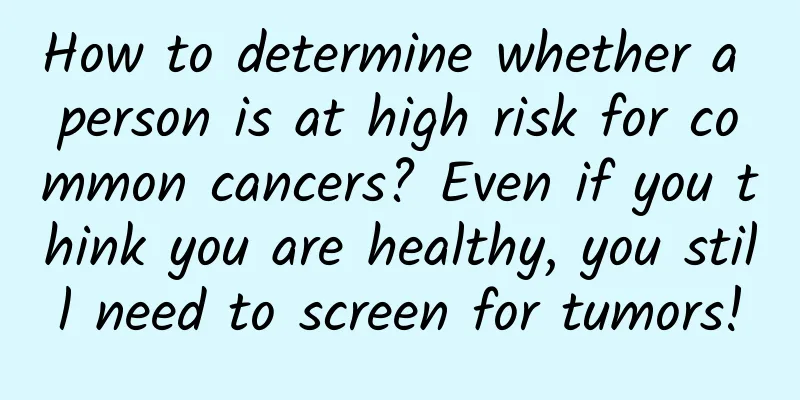How to determine whether a person is at high risk for common cancers? Even if you think you are healthy, you still need to screen for tumors!

|
Even if you think you are healthy, you still need to screen for tumors! Routine physical examinations are not equal to cancer prevention physical examinations Age Factor Age is a common risk factor for most cancers, and middle-aged and elderly people (over 40 years old) have a higher risk of cancer. Whether there is a history of cancer in the immediate family Find out whether these cancers have a hereditary tendency. If so, especially if you have relatives who had cancer at a young age, it is recommended to include special examinations in the cancer prevention screening list. Viral infection Such as persistent infection with HPV (human papillomavirus), persistent infection with Epstein-Barr virus, and infection with hepatitis B virus and hepatitis C virus. Determine whether there are bad living habits Bad living habits are also an important cause of cancer, such as long-term smoking, alcoholism, betel nut chewing, a high-fat, high-salt, low-fiber diet (eating less fresh vegetables and fruits, loving red meat, processed meat, sugary drinks), liking spicy food, staying up late, lack of exercise, long-term sitting, obese people, or long-term anxiety and depression. Whether there is precancerous lesion Such as esophageal leukoplakia, gastric and intestinal polyps, chronic atrophic gastritis, atypical hyperplasia, etc. There are high-risk factors for cancer in your living or working environment Long-term exposure to ionizing radiation, ultraviolet rays, long-term work in an environment with a lot of dust particles, or other occupational exposure history (asbestos, nickel, chromium, radon, etc.). History of long-term occupational exposure to dyes, rubber and plastic products, paint, leather, pesticides, etc. Air pollution from interior decoration materials, frequent contact with kitchen fumes, indoor open fires and coal heating, and exposure to radon gas in the soil and building materials in the living area. Tumors are preventable and curable . The tumor prevention and treatment system is divided into three levels: Primary prevention , i.e. prevention of etiology: developing good living habits, is prevention from the source such as viruses, environment, lifestyle, etc.; Secondary prevention is cancer screening: early detection, early diagnosis, and early treatment; Tertiary prevention is standardized diagnosis and treatment to improve cure rate, survival rate and quality of life. Tips: 1. High-risk factors only mean that there is a higher risk of cancer. The more risk factors there are, the higher the risk of cancer. However, it does not mean that you will definitely get cancer. Prevention is much easier and more effective than treatment of cancer. 2. Precancerous lesions are not cancer, but only a small part of them may develop into cancer. Many precancerous lesions can be maintained or even reversed by improving lifestyle habits and symptomatic treatment. Even if there is progress, it can be found through regular review and surgical treatment before it turns into cancer. 3. Cancer is a hidden disease. There may be no symptoms in the early stage. Even if there are some symptoms, they lack specificity and are not enough to alert people. Therefore, many cancers are often in the middle or late stages when they are clinically discovered. Therefore, individuals should not only understand the common cancer warning signs, but also pay attention to personal physical examinations and actively participate in cancer screening. |
>>: How to remove dark circles
Recommend
Can I cut my hair during the confinement period?
According to Chinese tradition, you cannot cut yo...
What does a woman's chicken breast look like?
People should not be unfamiliar with the disease ...
How many days is it normal for my period to be late?
Since every woman's physical health and const...
What is the cause of the granulation at the vaginal opening?
If a female friend finds granulations at the open...
What does clinical diagnosis of threatened abortion mean?
We all know that there are many ways of miscarria...
PocketGamer: Social game publishers’ fan data on social networks
We all know the importance of social media, but n...
What should pregnant women do if they have bad breath and oral discomfort?
The ten months of pregnancy is a painful and happ...
A woman had her breasts completely destroyed after just three operations
Breast cancer is the most common malignant tumor ...
What kind of oil is good for egg yolk crisps? How to make the egg yolk of egg yolk crisps flow oil
Egg yolk pastry has a light milky aroma. A milky ...
How to check Helicobacter pylori infection? Is the blood test really reliable?
Recommended academic articles related to this pop...
What should girls who are short and have thick legs wear to look good?
For short girls, the possibility of growing talle...
My period is dark and lasts longer.
The blood discharged by women during menstruation...
What is a dried apricot? Where is it produced?
Due to its unique natural quality and flavor, the...
Gynecological inflammation occurs frequently in summer, please do not ignore these 5 points
The weather is getting hotter and hotter, not onl...
Help, I stepped in shit!
Review expert: Wang Linyu, deputy chief physician...









